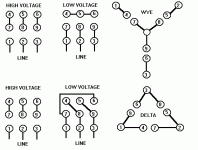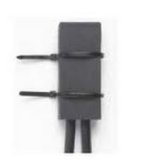As an ex-electrician gone rogue EE, I was trained, in the industrial sector, to do the following, and these methods are based on decades old principals of reliability and serviceability. Different from other connections, motor connections are EXPECTED to vibrate quite a bit, hence the ban on "wire nuts". There are two acceptable methods now.
A) The "modern" method is to use pre-made motor terminals, often called "Polaris connectors" because they are the most popular brand. If you google an image of them, you will see what I mean. Many companies now offer them besides Polaris and they are all likely good.
B) The "old fashioned" way I was originally taught, which uses common items an electrician was expected to carry at all times, which if you can't get Polaris connectors, you should learn to do to avoid getting delayed.
1) Ring tongue crimp terminals on the ends of the leads, making sure you use the PROPER crimping tool per the terminal mfr. Since the connection will end up insulated later, don't use the insulated crimps, the insulation plastic can cause the tool to slip to one side and cut strands or not crimp tight enough.
2) Steel fine thread machine screws, nuts, a flat washer and a lock washer. Because of the vibration a lock washer alone will bite into the softer copper of the terminal and over time, might lead to failure.
3) Wrap the bolted connection with varnished cambric splice tape. The purpose of this is to facilitate future easy removal of the insulation because this tape has no glue so when you cut the other layers off next time, you don't have a mess. Remember, motors need periodic removal and refurbishing, so you are thinking of the NEXT guy who might be laying on his back in greasy dirt trying to get the tape off; and that guy just might be you! A common sort cut if you don't have varnished cambric tape is to use black electrician tape "backwards", meaning sticky side out, so the glue is not on the bolts.
3) Rubber "splicing tape", 3M #88 or equal, 3 layers minimum. Rubber tape helps ensure that if the connection touches the side wall of the box, it will take a lot longer for the vibration to wear through the tape.
4) Plastic "electricians tape", 3M #33+ or equal, 2 layers, on top of the rubber tape to keep the rubber tape from unraveling.
Lots of people take shortcuts of course, but this is the RIGHT way to do it.
 )
)





